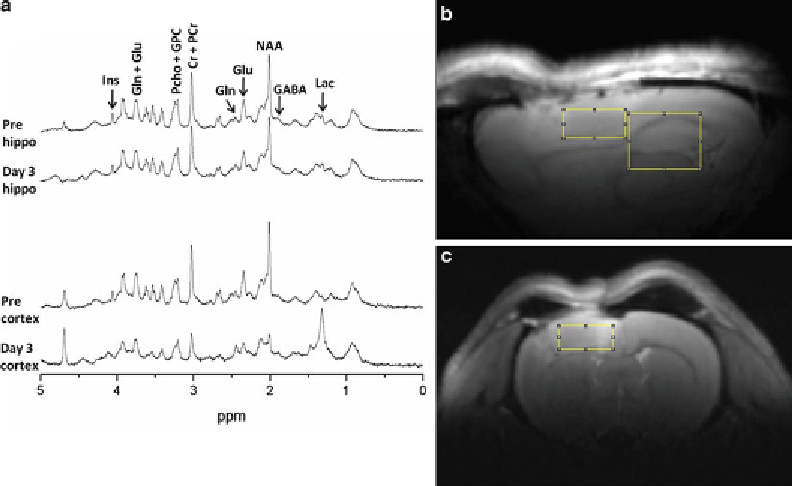Biology Reference
In-Depth Information
Fig. 2. Representative proton MR spectra and voxel localization. A 9.4 T scanner was used to obtain MR spectra
(TR = 4,000 ms; TE = 2 ms) from a 3 × 2.5 × 3 mm voxel over hippocampus, corpus callosum, and dorsal thalamus, and
from a 2.7 × 1.3 × 2.7 mm voxel over cerebral cortex. Spectra were collected preinjury and then at 3 days after controlled
cortical impact in rats. (
a
) The spectra show injury-induced changes in brain neurochemicals within both voxel locations.
In hippocampal tissue that appears normal with conventional MR, NAA is reduced by 20% 3 days after TBI. In cortical tissue
directly at the site of impact, NAA and Creatine are dramatically reduced (70% and 54%) while Lac is greatly increased
after injury (14-fold). (
b
and
c
) T2-weighted MR images from 3 days after TBI showing cortical and hippocampal voxel
locations. (
b
) Sagittal image showing cortical and hippocampal voxels. (
c
) Coronal image showing the cortical voxel. The
hippocampal voxel is out of the plane of view. While using a surface RF coil optimizes sensitivity for MRS, it results in visible
ventral signal dropoff in these images. Note edema in the injured cortex and downward shift of the corpus callosum from
cortical swelling.
The earliest MRS experiments in animal models of TBI used
31
P-MRS to quantify adenosine triphosphate, adenosine diphos-
phate, phosphocreatine (PCr), inorganic phosphate (Pi), and the
free phosphomonoester and phosphodiester components of mem-
branes. By calibrating the precise position (chemical shift) of the Pi
peak within the spectrum, a noninvasive estimate of the intracellular
pH can be obtained. Similarly, since ATP binds magnesium, esti-
mates of the magnesium concentration in vivo can also be made
following careful measurements of the chemical shift of the ATP
resonances. Following fl uid percussion injury, the PCr/Pi ratio has
been shown to decline and the tissue was acidotic, although no
changes in ATP, indicating impaired energy metabolism, were
detected (
15
). Other studies have shown reduced intracellular Mg
2+
following TBI that is attenuated by intravenous supplementation.
Of potential clinical signifi cance, Mg2
+
concentration was correlated
with postinjury performance on the rotorod (
16
).

Search WWH ::

Custom Search